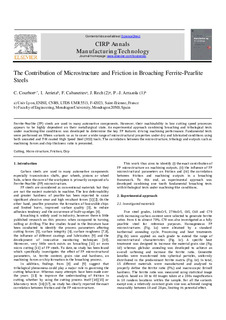
Title
The contribution of microstructure and friction in broaching Ferrite–Pearlite steelsOther institutions
Université de LyonVersion
Postprint
Rights
© 2020 CIRPAccess
Open accessPublisher’s version
https://doi.org/10.1016/j.cirp.2020.04.023Published at
CIRP Annals Vol. 69. N. 1. Pp. 57-60, 2020xmlui.dri2xhtml.METS-1.0.item-publicationfirstpage
57xmlui.dri2xhtml.METS-1.0.item-publicationlastpage
60Publisher
Elsevier Ltd.Keywords
cuttingMicro structure
Friction
chip
Abstract
Ferrite-Pearlite (FP) steels are used in many automotive components. However, their machinability in low cutting speed processes appears to be highly dependent on their metallurgical state. An experim ... [+]
Ferrite-Pearlite (FP) steels are used in many automotive components. However, their machinability in low cutting speed processes appears to be highly dependent on their metallurgical state. An experimental approach combining broaching and tribological tests under machining-like conditions was developed to determine the key FP features driving machining performance. Fundamental tests were performed on fifteen variants so as to cover a wide range of microstructural properties under dry and lubricated conditions using both uncoated and TiN coated High Speed Steel (HSS) tools. The correlation between the microstructure, tri-bology and outputs such as machining forces and chip thickness ratio is presented. [-]
xmlui.dri2xhtml.METS-1.0.item-sponsorship
Unión Europeaxmlui.dri2xhtml.METS-1.0.item-projectID
info:eu-repo/grantAgreement/EC/RFCS/RFSR-CT-2014-00020/EU/Innovative Method dedicated to the development of a ferrite-pearlite grade regarding its Machinability/IMMACCollections
- Articles - Engineering [749]




















